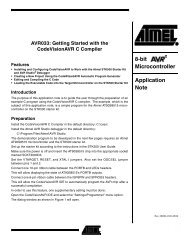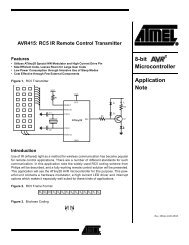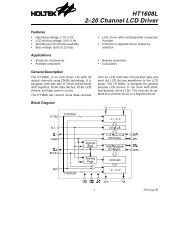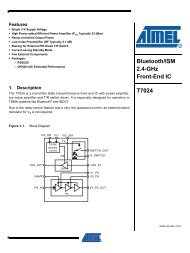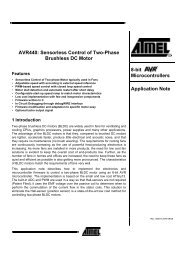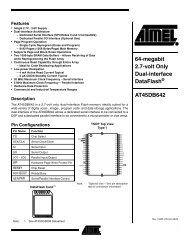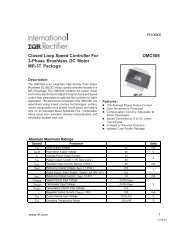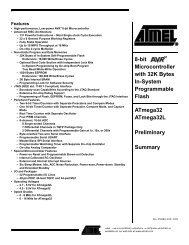AVR501: Replacing ATtiny15 with ATtiny25
AVR501: Replacing ATtiny15 with ATtiny25
AVR501: Replacing ATtiny15 with ATtiny25
You also want an ePaper? Increase the reach of your titles
YUMPU automatically turns print PDFs into web optimized ePapers that Google loves.
Table 7-3. Changes to Bit Names.<strong>ATtiny15</strong><strong>ATtiny25</strong>Bit Name Register Address Bit NamePWM1 TCCR1 $30 PWM1AWDTOE WDTCR $21 WDCEEEMWE EECR $1C EEMPEEEWE EECR $1C EEPEADFR ADCSR $06 ADATE8 Interrupt Vectors9 Timer/Counters9.1 Compatibility Mode<strong>ATtiny25</strong> has more interrupt vectors than <strong>ATtiny15</strong>, but all <strong>ATtiny15</strong> vectors exist inidentical locations on the <strong>ATtiny25</strong>. Programs can still use the end of <strong>ATtiny15</strong>interrupt vector table as a starting address on <strong>ATtiny25</strong>, provided that <strong>ATtiny25</strong>specific interrupts are not enabled.Timer/Counter1 of <strong>ATtiny25</strong> is by default not identical to timer/counter1 of <strong>ATtiny15</strong>;however, it can be operated in <strong>ATtiny15</strong> Compatibility Mode by writing 0011 toCKSEL fuses.See section 7 for renamed registers and bits. The output compare register OCR1B in<strong>ATtiny15</strong> is replaced <strong>with</strong> OCR1C, which have the same functionality. See<strong>ATtiny25</strong>/45/85 data sheet for full details on timer1 operation in compatibility mode.10 Analogue ComparatorThe bandgap reference voltage in <strong>ATtiny25</strong> is not the same as in Attiny15; In<strong>ATtiny15</strong> the nominal bandgap voltage is 1.22 V and in <strong>ATtiny25</strong> it is 1.1 V (or 2.56V).This means that <strong>ATtiny15</strong> applications where the positive input of the comparator isrouted to the internal reference voltage may behave differently on <strong>ATtiny25</strong>. Thedefault setting is not to route the internal reference voltage to the input of theanalogue comparator.11 I/O Ports11.1 Drive Strength6 <strong>AVR501</strong>Port pin PB5 of <strong>ATtiny15</strong> can be configured as an input or an open-drain output, whilein <strong>ATtiny25</strong> it performs as a general I/O like PB0:4, <strong>with</strong> pull-up capability.Port drivers of <strong>ATtiny15</strong> have a higher current sink rating but a lower current sourcerating than those of <strong>ATtiny25</strong>. This means that <strong>ATtiny15</strong> applications where highcurrent is sunk via I/O pins may exceed <strong>ATtiny25</strong> device limits. Applications where I/Opins are used for sourcing current are not affected. Port driver characteristics areoutlined in the Table 11-1.2590A-AVR-03/05





